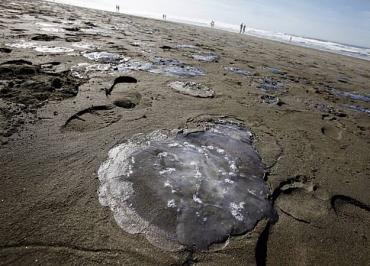
Not from the natural beauty of sand, surf and sea, but from a great slick of dead jellyfish that mysteriously washed ashore near Pacheco Street.
More than 10,000 of the gooey invertebrates, each about the size of a dinner plate, drifted onto the beach Friday evening. By Sunday, they had attracted hordes of the curious, the repulsed and the fascinated.
Kids stomped them. Dogs rolled in them. Surfers tossed them at each other. Some people tiptoed fearfully around them, while others pressed in with cameras for close-ups.
"I first saw it and thought, am I hallucinating?" said Nan Madden of San Francisco as she walked her yellow Labrador through the slimy swath Sunday morning. "I've never seen anything like it. I sent pictures to my grandkids."
It's not the first time that thousands of the brainless, heartless, headless critters have drifted onto Ocean Beach. In 2004, the shoreline was visited by thousands of a type of smaller jellyfish known as by-the-wind sailors.
'A normal resident'
The phenomenon is nothing to be alarmed about, experts said. Jellies tend to congregate in groups, called blooms, and tides, wind, swells and currents sometimes combine to send the blooms ashore. Ocean Beach had seen a heavy-duty swell before the jelly invasion.
"This is a good time to take a close look, because when the tide comes in they'll be gone, back into the soup of the ocean," said Ken Peterson, a spokesman for the Monterey Bay Aquarium, which houses the world's largest jellyfish collection. "You might want to hold your nose, though."
Jellyfish have been washing ashore around San Francisco Bay for at least 500 million years, said Mike McGill, a marine biologist at the Aquarium of the Bay at Pier 39.
"They are a normal resident," he said. "We have perfect conditions for them here. This is absolutely a natural phenomenon."
The California coast is home to about 20 species of jellyfish, and all appear to be thriving. They're so plentiful, in fact, that leatherback sea turtles swim 8,600 miles from Indonesia to feast upon them.
The jellyfish coating Ocean Beach are likely moon jellies, the experts said, which have a pinkish hue and leave intricate, flowerlike imprints in the sand when they dry up.
Stings on mild side
Moon jellies are among the tamer jellyfish, as opposed to Portuguese man o' war or box jellies, whose stings can be fatal to humans. Moon jelly stings are so mild the toxins rarely penetrate human skin. Unless a person has an allergy to moon jelly toxins, they might not know they'd been stung at all.
Nonetheless, beachgoers are advised not to traipse barefoot among Ocean Beach's jellies or coddle them bare-handed. Jellyfish stings can dispense toxins even after the jellyfish is dead, Peterson said.
That didn't stop legions of kids from playing with the gelatinous blobs, though.
'Nature washing up'
"They basically look like water," said Kaylee Flores, 8, of San Francisco, as she poked jellyfish with a rock. "Once I saw some tiny little ones, but these are bigger."
Kaylee and her mom, Stephanie Dale, visited the beach expressly to view the jellies before they dried up, were squished into the sand or slurped up by the tide.
"It's nature washing up on a city beach," said Dale.
Jason Banister, a surfer from San Francisco, said jellyfish are a common sight offshore but somewhat shocking on the beach.
"It's crazy. I've never seen anything like this before," he said. "This morning, all up and down the beach, it was straight jellyfish."
E-mail Carolyn Jones at carolynjones@sfchronicle.com.
This article appeared on page C - 1 of the San Francisco Chronicle



Reader Comments
to our Newsletter